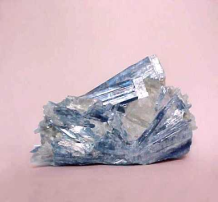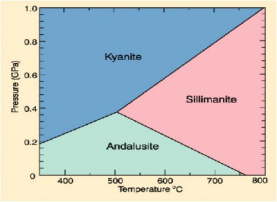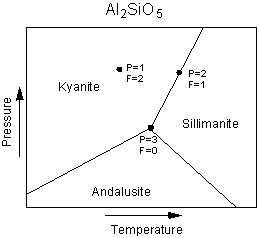Introduction
In their mission to understand nature, geologists have managed to identify thousands of minerals and mineral deposits that are spread worldwide. Following these discoveries, it has been necessary to come up with effective methods to facilitate identification and differentiation of various mineral types .
Kyanite is a mineral whose occurrence and properties have been studied extensively. Correspondingly, this report will focus on this significant mineral by exploring its physical properties, chemical composition, lattice, and crystallography. In addition, the report will also highlight the physical conditions under which Kyanite exhibits stability, environmental factors that favor its formation, its associated minerals, its uses, environmental hazards associated with its occurrence, as well as its geological importance.
Background of Kyanite
Kyanite is a free occurring aluminosilicate mineral which chemical formula is similar to the other two polymorphs under the umbrella of silimanite group. The three polymorphs “kyanite, silimanite, and andalusite ‘exhibit the same chemical formula Al2SiO5, but are usually differentiated by their crystal structure.
This similarity between the three polymorphs implies that one can be used in place of the other. Kyanite, whose original spelling was cyanite, has its origins in Greek language ‘kyanos’ meaning blue because of its most familiar color (Government Printing Office 102).

Properties of Kyanite
According to Shigeaki, Nakajima and Kenichi Funakoshi (1625), mineralogists utilize mineral properties to identify and differentiate minerals. While some of these properties are easily identifiable (color, shape), others (chemical composition, hardness) are identified after a series of laboratory experiments.
Against this background, mineralogists have identified several characteristics such as color, hardness, magnetism that form the basis of mineral identification. The table below identifies some significant properties that are often used to identify and classify Kyanite mineral.
Table 1: Properties of Kyanite
Uses of Kyanite
Industrial uses
Due to its high resistance to extreme temperatures, Kyanite is used in the manufacture of industrial products that are purposed to exhibit heat resistance properties. Some of these products include; kiln furnaces and refractory bricks and mortars. In addition, it uses manufacture heat resistance products such as clutch facings and brake shoes (Mineral Miners n.p.).
Porcelain strengthening
Kyanite exhibits some special properties that make it suitable for manufacturing a special type of porcelain (high refractory) that can withstand extreme temperatures. For instance, the white porcelain insulator is often used in spark plug, which is usually exposed to excessive heat. In addition, Kyanite is also used to make other types of porcelain that are not necessarily refractory (Mineral Miners n.p.).
Kyanite in Abrasive Products
Kyanite hardiness and heat resistance property also make it suitable for making abrasive products. However, it is used a binding agent, but not as a primary abrasive. For instance, it is used in making abrasive particles that are used to manufacture cutting and grinding wheels (Mineral Miners n.p.).
Kyanite Gemstones
In addition, due to its transparently and lustrous colors, Kyanite is quite popular in gemstone cutting. However, not all types of Kyanite can be used in making gemstone, but a rarely occurring clear and colorful crystal , hence making these gemstones very expensive (Shigeaki, Nakajima & Funakoshi 1625).
Minerals associated with polymorphs
As aforementioned, Kyanite has two sister polymorphs; andalusite and sillimanite. In addition, it is associated with other silicate minerals which fall under Nesolsicate class. These minerals include; quartz (SiO2), micas (AB2-3(X, Si)4O10(O,F,OH)2), garnets (A3B2(SiO4)3), and staurolite (Fe2Al9Si4O22(OH)2) (Shigeaki, Nakajima & Funakoshi 1626).
Environments of formation
In spite of the fact that Kyanite, andalusite, and sillimanite are polymorphs, their environments of formation are different. Due to this disparity, the three minerals demonstrate different appearances. Kyanite formation in metamorphic rocks is favored by low temperatures and high pressures. On the other hand, sillimanite formation is favored by relatively high pressures and high temperatures as well. In addition, andalusite prefers both the pressures and temperatures to be low (Shigeaki, Nakajima & Funakoshi 1626).
Geological significance
Kyanite and its associated polymorphs are commonly found worldwide, thus making them very useful in geology. Geologists use these minerals to study formation of metamorphic rocks taking into consideration their different environment formation conditions.
According to Shigeaki, Nakajima and Funakoshi (1628), it is extremely rare to find the three mineral deposits within the same rock due to their diverse environmental specifications. However, the above situation is not entirely impossible, and if it happens that the three are found within the same rock, it is an indication that the rock is special, hence forming the basis for further investigation.
For instance, if a geologist discovers Kyanite minerals in a metamorphic rock, he/she would absolutely conclude that the rock was formed under high pressure and low temperatures below 800 degrees Celsius (mineralminers.com). The latter author also underscores that geologists can utilize recognized mineral conditions to investigate the unknown using what is called phase diagrams like the one shown below.

Physical conditions of stability
As mentioned earlier, Kyanite is formed under two crucial conditions (high pressures and low temperatures). This implies that, for this mineral to be formed the desired conditions have to remain constant to ensure stability. Kyanite and its polymorphs can be represented in the phase diagram below to demonstrate how pressure and temperature determine their stability.
From the diagram below, it is evident that, if pressure changes, temperature must also be altered to ensure the stability of the three polymorphs (Mineral Miners n.p.). However, this change is only enabled at point P1 and P2, but prohibited in P3 because any change in pressures and temperatures at point P3 will alter the number of phases, thus destabilizing the equilibrium, which enable coexistence of the three polymorphs.

Environmental hazards
According to Government Printing Office (201), environmental hazards associated with minerals usually occur during mining and processing. Mostly, Kyanite environmental hazards are linked with waste generation and disposal. In its natural form, Kyanite is non-hazardous, but biological, chemical, and engineering methods, which are adopted during processing, may generate various hazardous by-products. On this note, it is the responsibility of miners to eliminate the probable hazards during mining and processing of minerals (216).
Works Cited
Government Printing Office. Minerals Yearbook Metals and Minerals 2006. New York: U.S Geological Survey, 2009. Print.
Mineral Miners. Kyanite: Mineral information page, 27 June 2011. Web.
Shigeaki, Ono, Yoichi Nakajima, and Kenichi Funakoshi. “In situ observation of the decomposition of kyanite at high pressures and high temperatures”. American Mineralogist 92 (2007): 1624 – 1629.